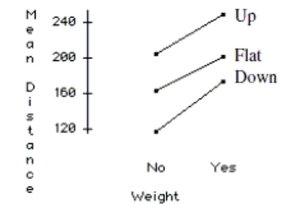A student wants to build a paper airplane that gets maximum flight distance. She tries
three ways of bending the wing (down, flat, and up) and two levels of nose weight (no and yes
- a paper clip). She randomizes the 12 runs (each condition replicated twice). The analysis
of variance for the 12 runs is shown in the table below along with an interaction plot and
tables of the mean distance for the different wing bends and weights. 
a. Does an additive model seem adequate? Explain.
b. Write a report on this analysis of the data. Include any recommendations you would
give the student on designing the plane.
Definitions:
Confession
The act of admitting to something, particularly acknowledging one's sins or wrongdoings, often within a religious or legal context.
Duress
A compulsion by threat or force; a condition in which a person acts as a result of pressure or coercion.
Jury
A jury is a group of people sworn to render a verdict in a legal case on the basis of evidence presented to them in a court.
Covariation Principle
A theory suggesting that people attribute behavior to causes that appear at the same time as the behavior and are absent when the behavior does not occur.
Q2: It is possible that the distance
Q3: Define observational study and experiment. Define the
Q5: Here is the corresponding regression table:
Q18: For each of 200 randomly selected cities,
Q49: Graduation tests Many states mandate tests that
Q52: Test an appropriate hypothesis and state your
Q84: Describe a disadvantage of using volunteers in
Q105: Approval rating A newspaper article reported
Q111: Is this study blind?
Q125: Which of the following is true about